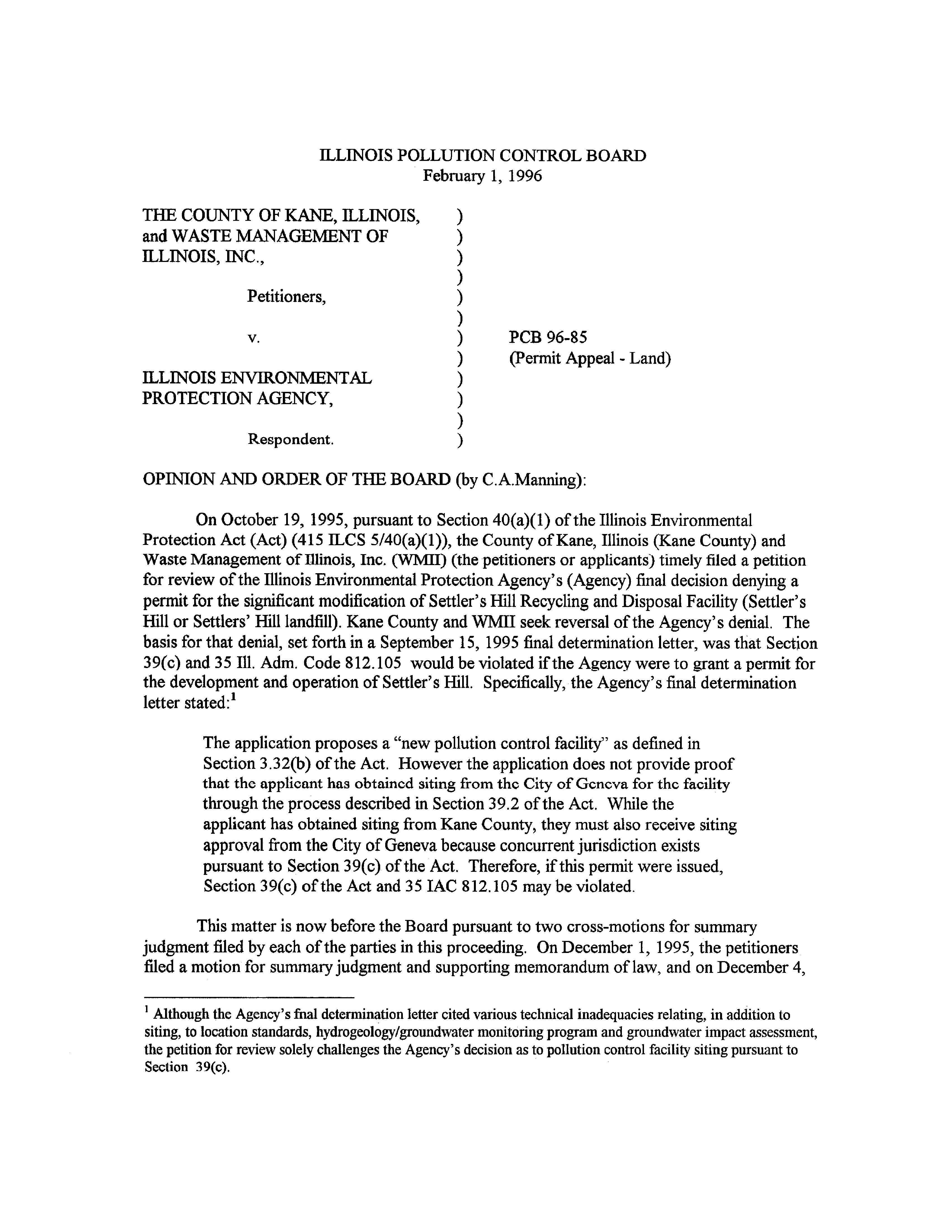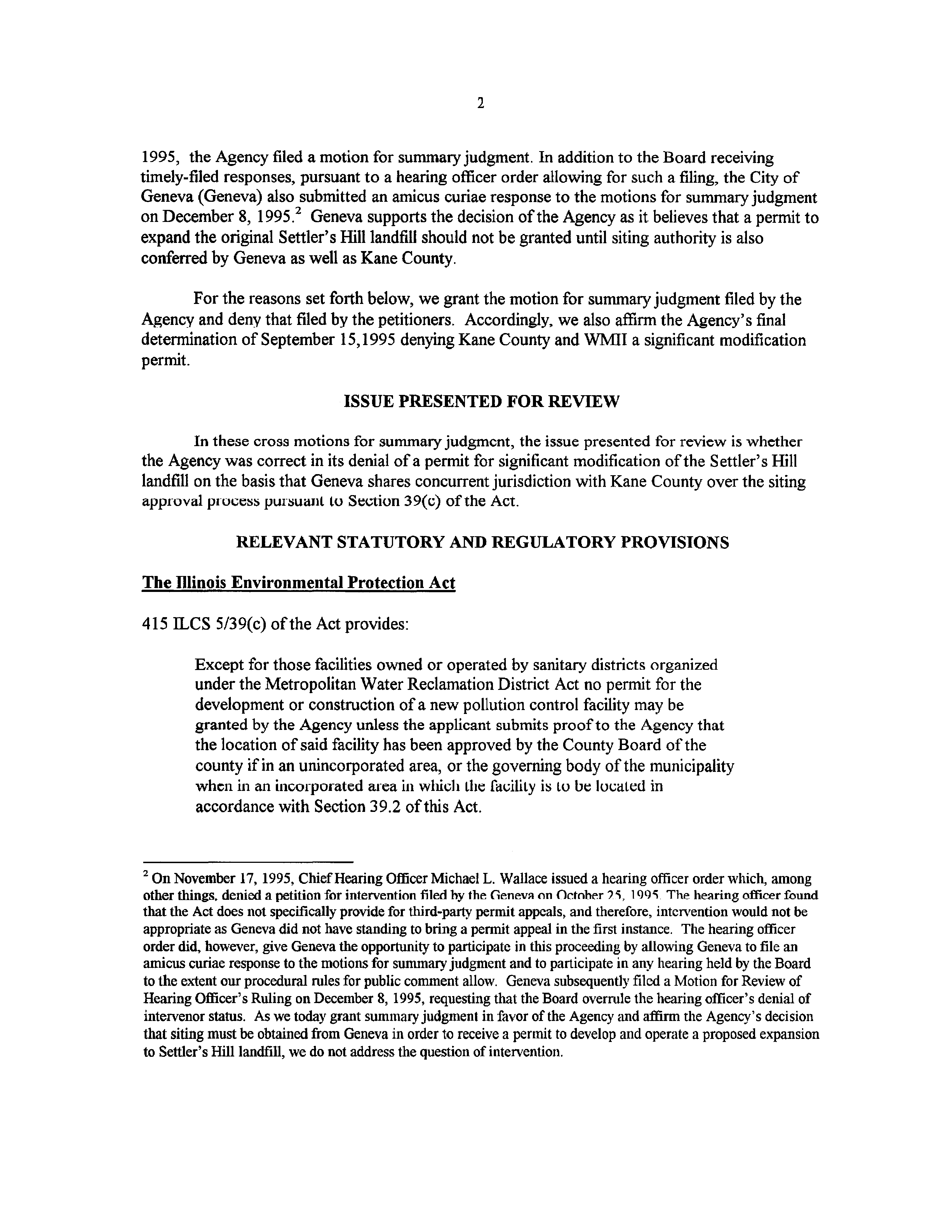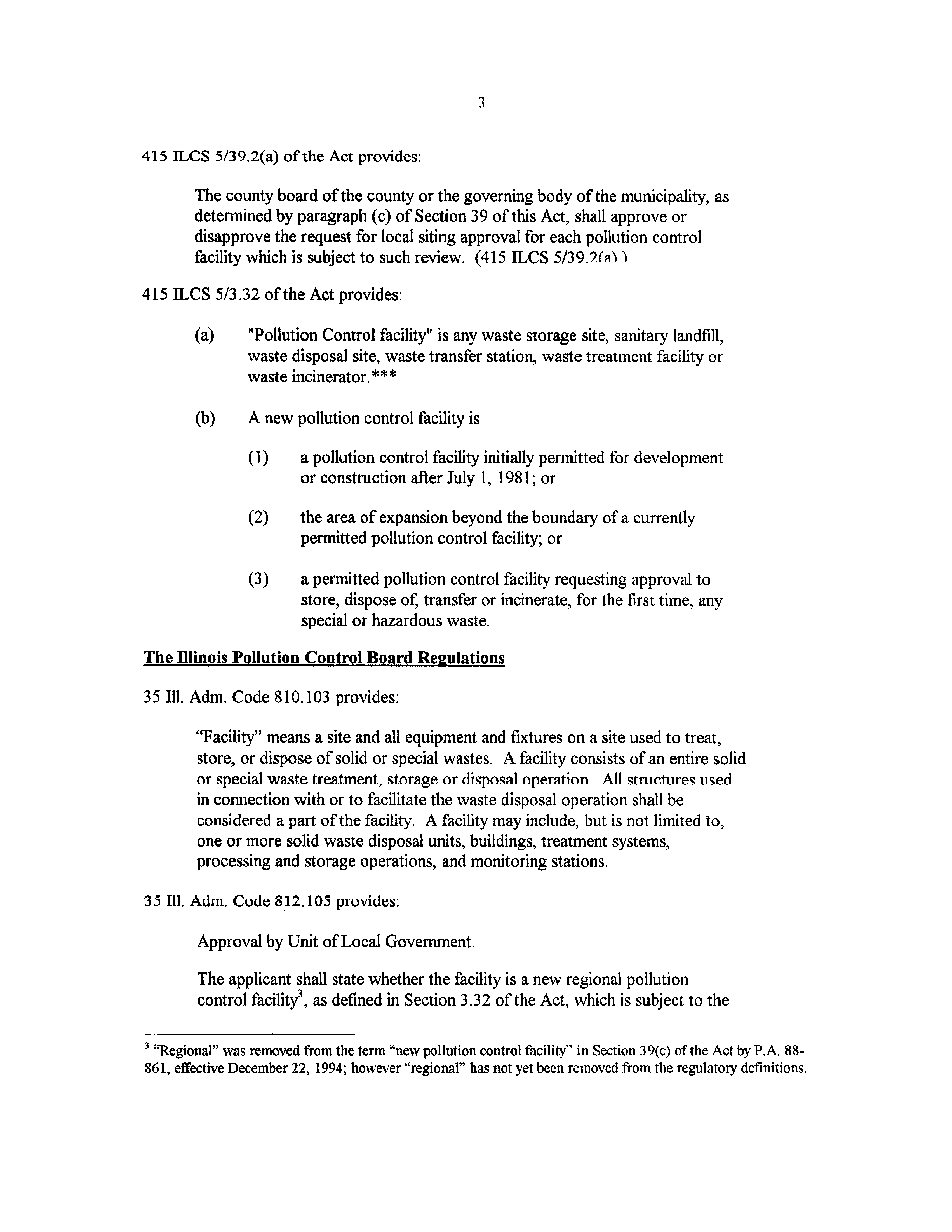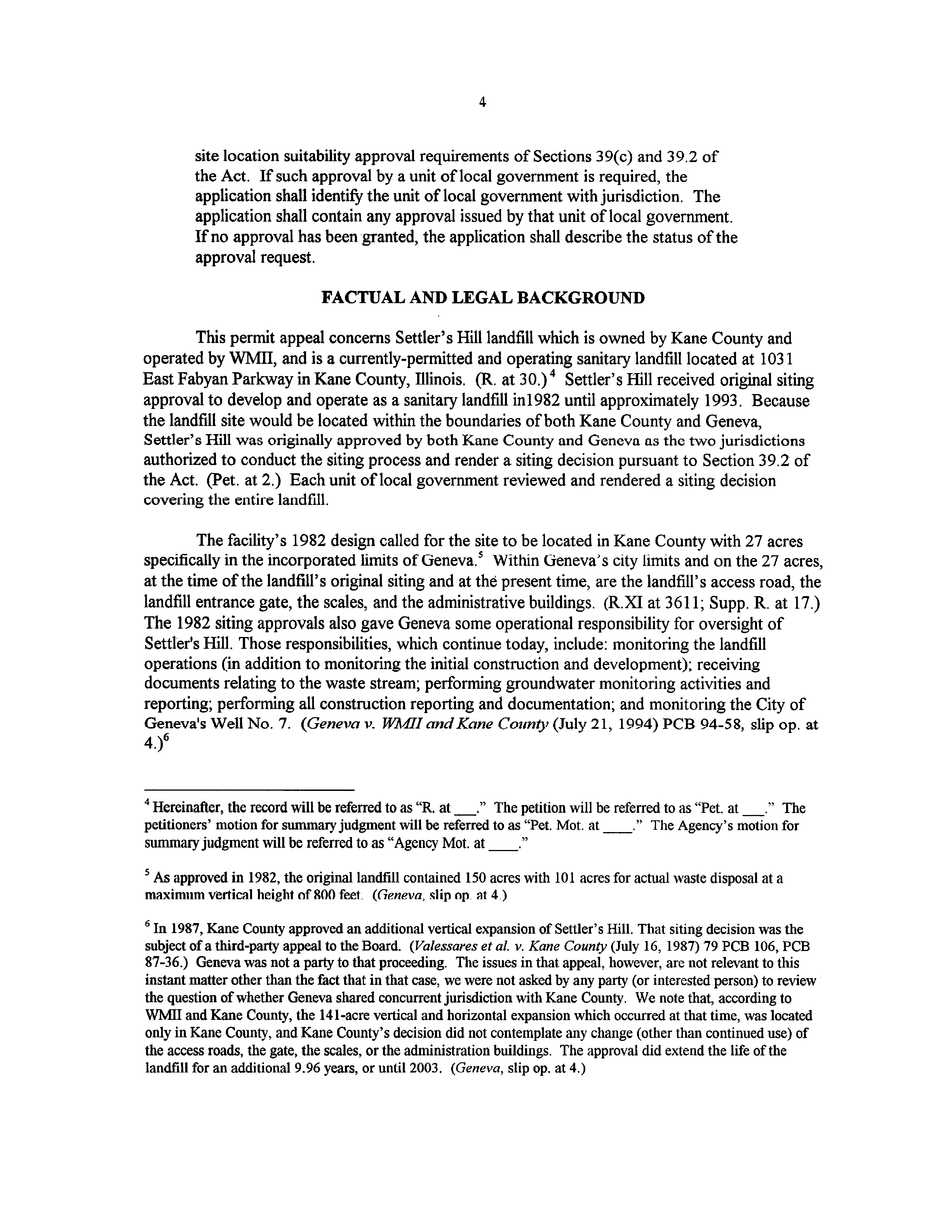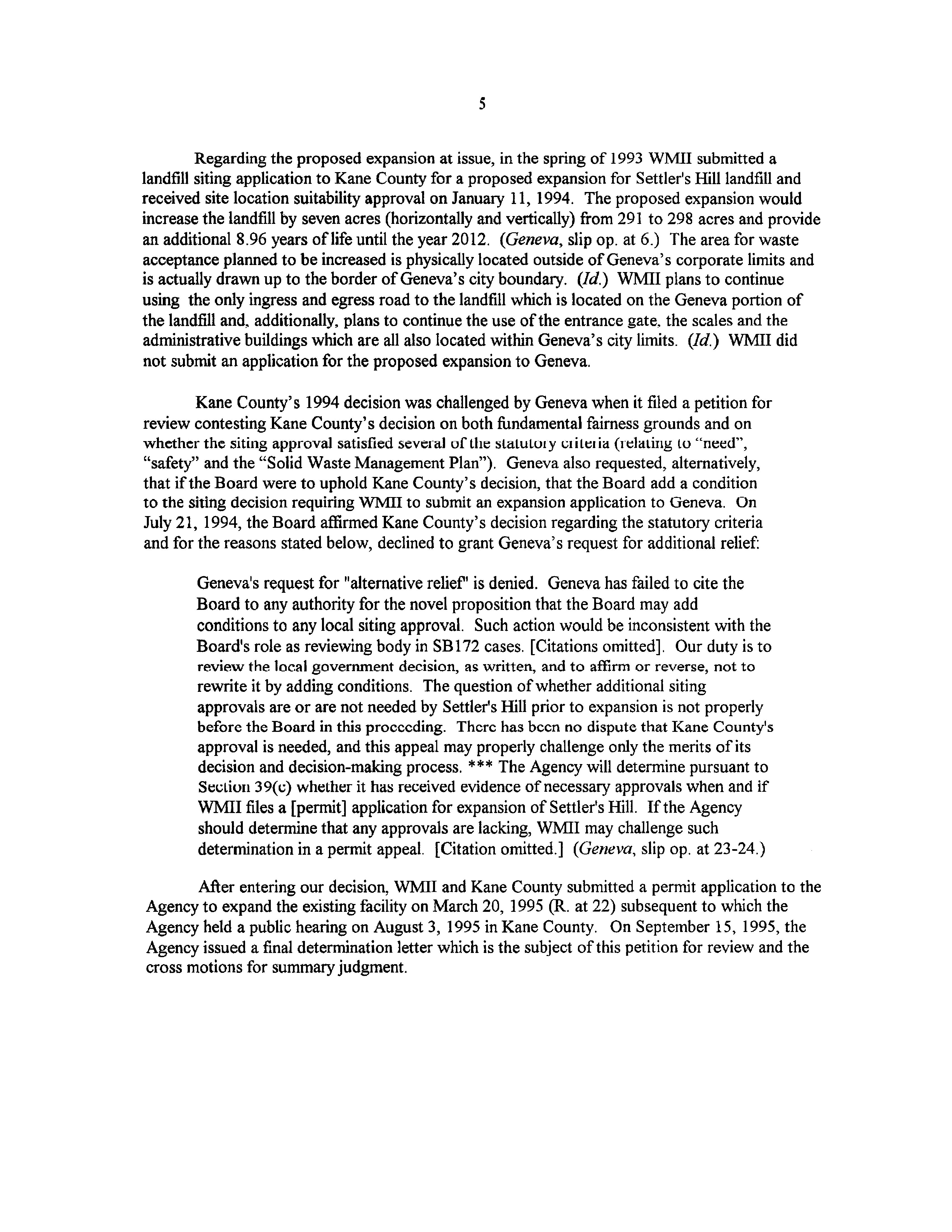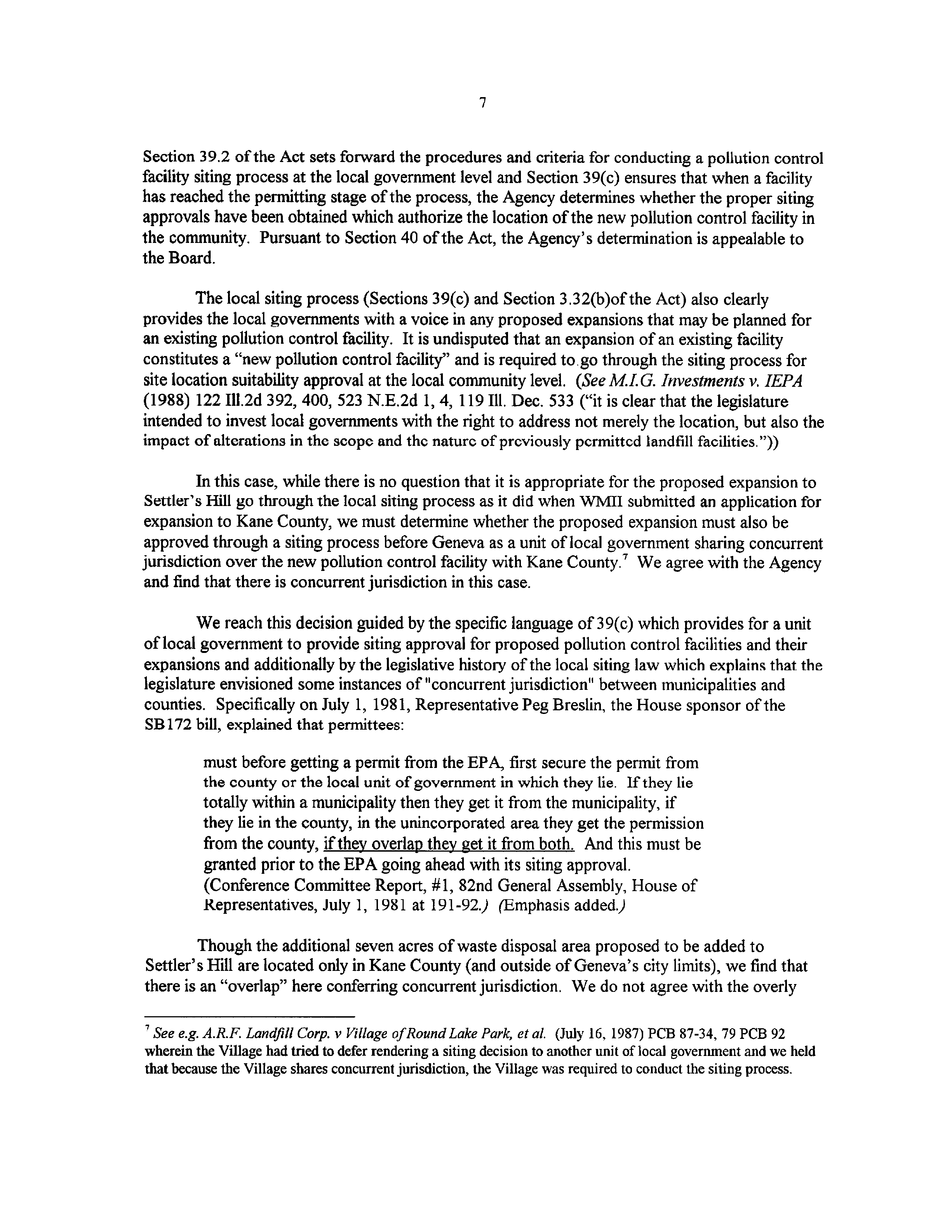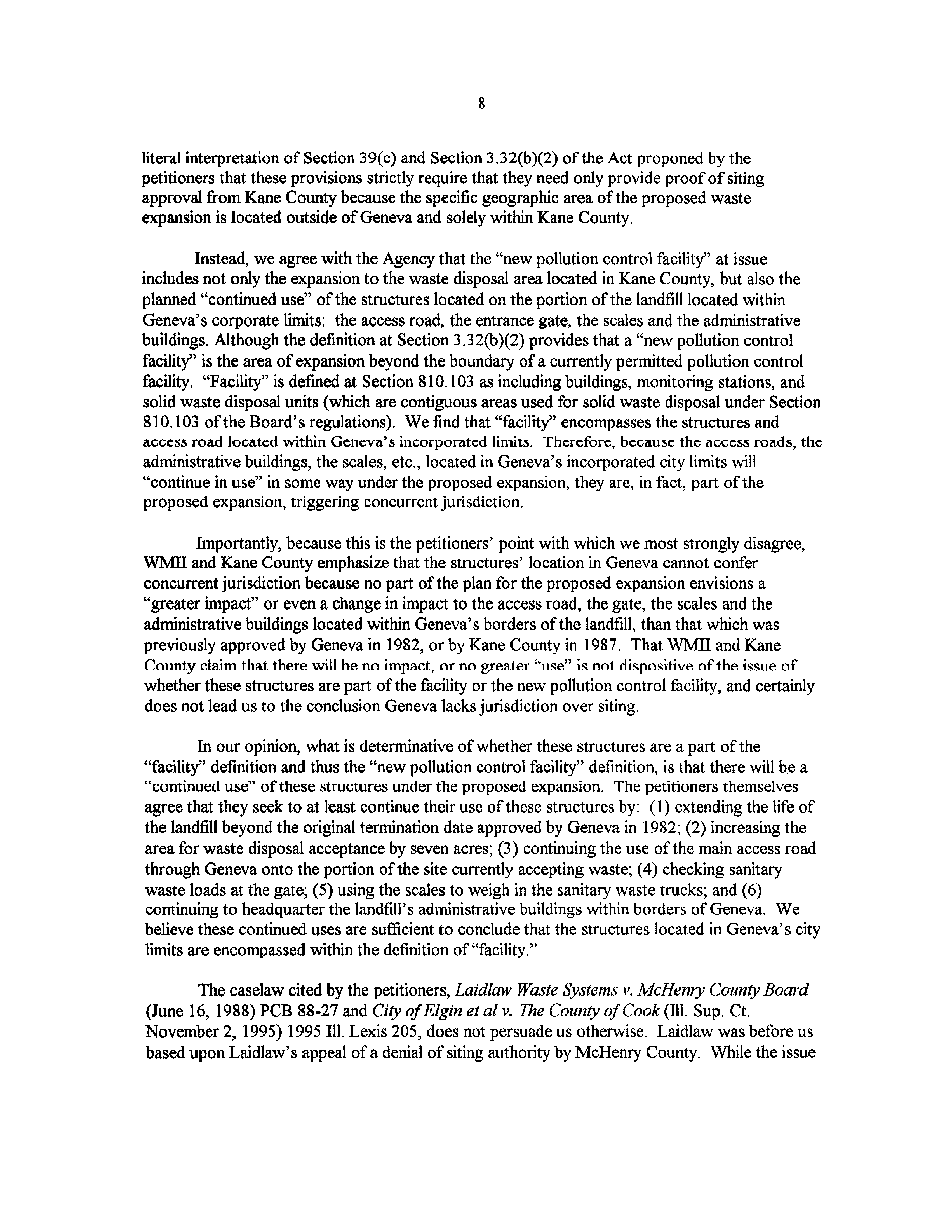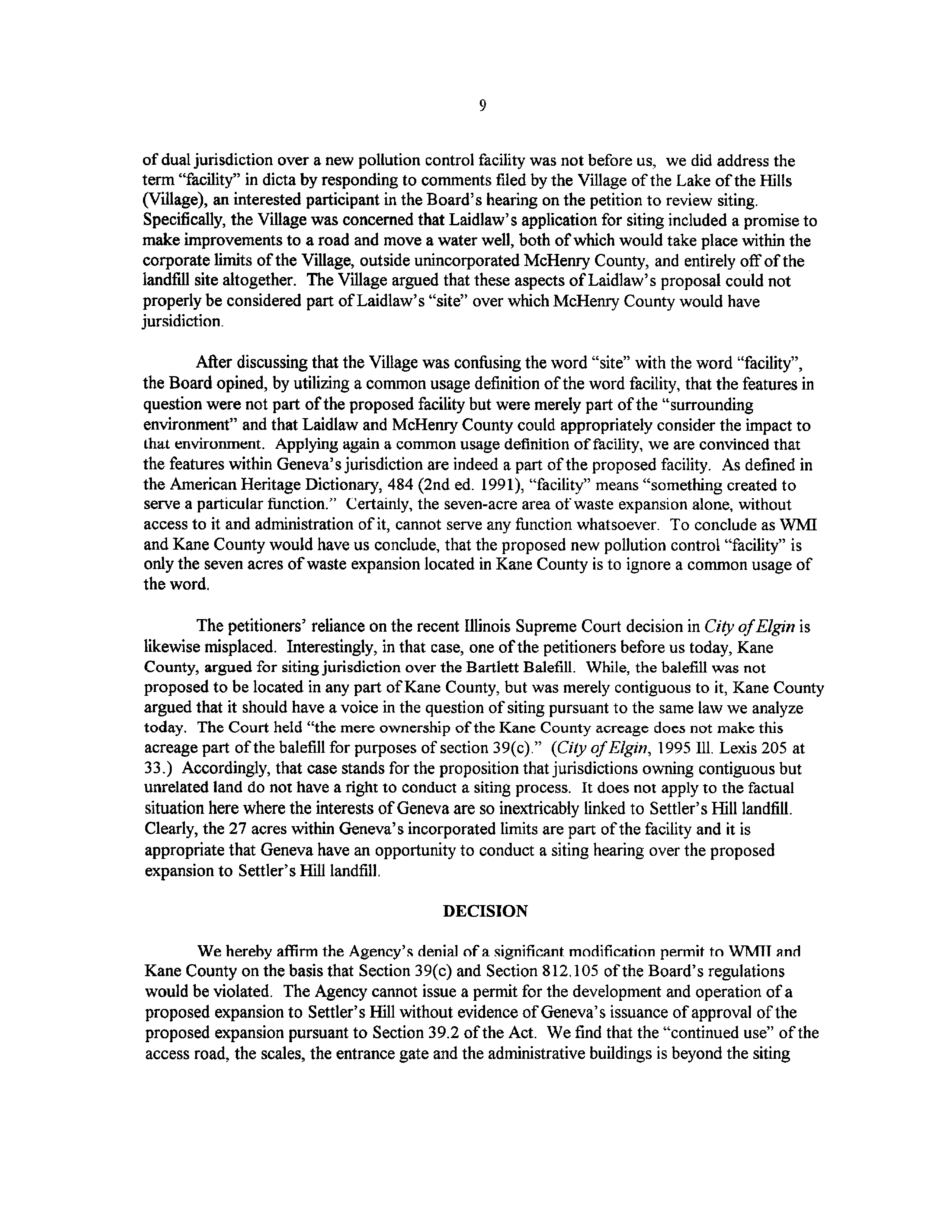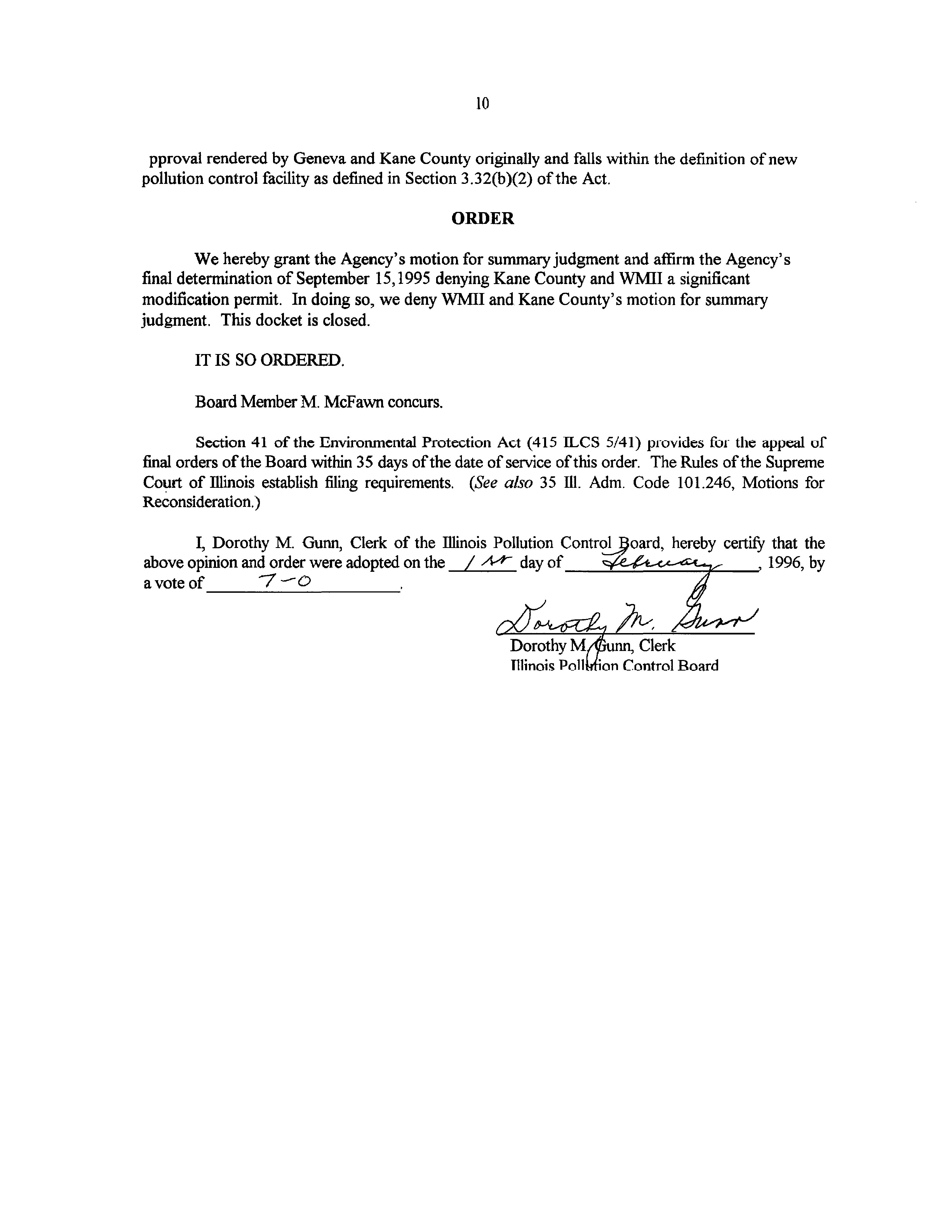ILLINOIS POLLUTION CONTROL BOARD
February 1, 1996
THE COUNTY OF KANE, ILLiNOIS,
)
and WASTE MANAGEMENT OF
)
ILLINOIS, rNC.,
)
)
Petitioners,
)
)
v.
)
PCB96-85
)
(Permit Appeal
-
Land)
ILLiNOIS ENVIRONMENTAL
)
PROTECTION AGENCY,
)
)
Respondent.
)
OPINION AND ORDER OF THE BOARD (by C.A.Manning):
On October 19, 1995, pursuant to Section 40(a)(1) of the Illinois Environmental
Protection Act (Act) (415 ILCS 5/40(a)(1)), the County of Kane, Illinois (Kane County) and
Waste Management of illinois, Inc. (WIts’llI) (the petitioners or applicants) timely filed a petition
for review of the Illinois Environmental Protection Agency’s (Agency) final decision denying a
permit for the significant modification of Settler’s Hill Recycling and Disposal Facility (Settler’s
Hill or Settlers’ Hill landfill). Kane County and WMII seek reversal of the Agency’s denial. The
basis for that denial, set forth in a September 15, 1995 final determination letter, was that Section
39(c) and 35 Ill. Adm. Code 8 12.105 would be violated if the Agency were to grant a permit for
the development and operation of Settler’s Hill. Specifically, the Agency’s final determination
letter stated:’
The application proposes a “new pollution control facility” as defined in
Section 3.32(b) of the Act. However the application does not provide proof
that the applicant has obtained siting from the City of Geneva for the facility
through the process described in Section 39.2 of the Act. While the
applicant has obtained siting from Kane County, they must also receive siting
approval from the City of Geneva because concurrent jurisdiction exists
pursuant to Section 39(c) of the Act. Therefore, if this permit were issued,
Section 39(c) of the Act and 35 IAC 8 12.105 maybe violated.
This matter is now before the Board pursuant to two cross-motions for summary
judgment filed by each ofthe parties in this proceeding. On December 1, 1995, the petitioners
filed amotion for summaryjudgment and supporting memorandum of law, and on December 4,
‘Although the Agency’s thai determination letter cited various technical inadequacies relating, in addition to
siting, to location standards, hydrogeology/groundwater monitoring program and groundwater impactassessment,
the petition for review solely challenges the Agency’s decision as to pollution control facility siting pursuant to
Section 39(c).
2
1995, the Agency filed a motion for summaryjudgment. In addition to the Board receiving
timely-filed responses, pursuant to a hearing officer order allowing for such a filing, the City of
Geneva (Geneva) also submitted an amicus curiae response to the motions for summaryjudgment
on December 8, 1
995~2
Geneva supports the decision of the Agency as it believes that a permit to
expand the original Settler’s Hill landfill should not be granted until siting authority is also
conferred by Geneva as well as Kane County.
For the reasons set forth below, we grant the motion for summaryjudgment filed by the
Agency and deny that filed by the petitioners. Accordingly, we also affirm the Agency’s final
determination of September 15,1995 denying Kane County and WPv~1I a significant modification
permit.
ISSUE PRESENTED FOR REVIEW
In these cross motions for summaryjudgmcnt, the issue presented for review is whether
the Agency was correct in its denial ofa permit for significant modification ofthe Settler’s Hill
landfill on the basis that Geneva shares concurrent jurisdiction with Kane County over the siting
approval pwcess pursuant to Section 39(c) of the Act.
RELEVANT
STATUTORY AND REGULATORY PROVISIONS
The Illinois Environmental Protection Act
415 ILCS
5/39(c)
ofthe Act provides:
Except for those facilities owned or operated by sanitary districts organized
under the Metropolitan Water Reclamation District Act no permit for the
development or construction of a new pollution control facility may be
granted by the Agency unless the applicant submits proofto the Agency that
the location of said facility has been approved by the County Board of the
county if in an unincorporated area, or the governing body ofthe municipality
when in an incorporated area in which the facility is to be located in
accordance with Section 39.2 of this Act.
2
On November 17,
1995,
ChiefHearing Officer Michael L. Wallace issued ahearing officer order which, among
other things, denied a petition for intervention filed
by the Geneva on October 25, 1995 The
hearing officer found
that the Actdoes not specifically provide for third-party permit appeals, and therefore, intervention would not be
appropriate as Geneva did not have standing to bring a pennit appeal in the first instance. The hearingofficer
order did, however, give Geneva the opportunity to participate in this proceeding by allowing Geneva to file an
amicus curiae response to the motions for sunimaryjudgnient and to participate in any hearing held by the Board
to the extent our procedural rules for public comment allow. Geneva subsequently filed a Motion for Review of
Hearing Officer’s Ruling on December 8, 1995, requesting that the Board overrule the hearing officer’s denial of
intervenor status. As we today grant summary judgment in favor of the Agency and afllnn the Agency’s decision
that siting must be obtained from Geneva in order to receive apermit to develop and operate a proposed expansion
to Settler’s Hill landfill, we do not address the question ofintervention.
3
415 ILCS 5/39.2(a) of the Act provides:
The county board ofthe county or the governing body of the municipality, as
determined by paragraph (c) of Section 39 of this Act, shall approve or
disapprove the request for local siting approval for each pollution control
facility which is subject to such review. (415 ILCS 5/39.7.(a”
‘~
415 ILCS 5/3.32 ofthe Act provides:
(a)
“Pollution Control facility” is any waste storage site, sanitary landfill,
waste disposal site, waste transfer station, waste treatment facility or
waste incinerator.
~“~°K
(b)
A new pollution control facility is
(I)
a pollution control facility initially permitted for development
or construction after July 1, 1981; or
(2)
the area of expansion beyond the boundary ofa currently
permitted pollution control facility; or
(3)
a permitted pollution control facility requesting approval to
store, dispose of, transfer or incinerate, for the first time, any
special or hazardous waste.
The Illinois Pollution Control Board Regulations
35
Ill. Adm. Code 8 10.103 provides:
“Facility” means a site and all equipment and fixtures on a site used to treat,
store, or dispose of solid or special wastes. A facility consists of an entire solid
or special waste treatment, storage or disposal operation All structures used
in connection with or to facilitate the waste disposal operation shall be
considered a part ofthe facility. A facility may include, but is not limited to,
one or more solid waste disposal units, buildings, treatment systems,
processing and storage operations, and monitoring stations.
35 Ill. Adru. Code 812.105 provides:
Approval by Unit ofLocal Government.
The applicant shall state whether the facility is a new regional pollution
control facility3, as defined in Section 3.32 of the Act, which is subject to the
~“Regional” was removed from the term “new pollution control facility” in Section 39(c) of the Act by P.A. 88-
861, effective December 22, 1994; however “regional” has not yet been removed from the regulatory definitions.
4
site location suitability approval requirements of Sections 39(c) and 39.2 of
the Act. If such approval by a unit of local government is required, the
application shall identify the unit of local government withjurisdiction. The
application shall contain any approval issued by that unit of local government.
If no approval has been granted, the application shall describe the status ofthe
approval request.
FACTUAL AND LEGAL BACKGROUND
This permit appeal concerns Settler’s Hill landfill which is owned by Kane County and
operated by WMII, and is a currently-permitted and operating sanitary landfill located at 1031
EastFabyan Parkway in Kane County, Illinois. (R. at 30.)
~‘
Settler’s Hill received original siting
approval to develop and operate as a sanitary landfill in1982 until approximately 1993. Because
the landfill site would be located within the boundaries ofboth Kane County and Geneva,
Settler’s Hill was originally approved by both Kane County and Geneva as the two jurisdictions
authorized to conduct the siting process and render a siting decision pursuant to Section 39.2 of
the Act. (Pet. at 2.) Each unit of local government reviewed and rendered a siting decision
covering the entire landfill.
The facility’s 1982 design called forthe site to be located in Kane County with 27 acres
specifically in the incorporated limits of Geneva.5 Within Geneva’s city limits and on the 27 acres,
at the time of the landfill’s original siting and at the present time, are the landfill’s access road, the
landfill entrance gate, the scales, and the administrative buildings. (R.X1 at 3611; Supp. R. at 17.)
The 1982 siting approvals also gave Geneva some operational responsibilityfor oversight of
Settler’s Hill. Those responsibilities, which continue today, include: monitoring the landfill
operations (in addition to monitoring the initial construction and development); receiving
documents relating to the waste stream; performing groundwater monitoring activities and
reporting; performing all construction reporting and documentation; and monitoringthe City of
Geneva’s Well No. 7.
(Geneva v.
ff’MII
andKane
County
(July 21, 1994) PCB
94-58,
slip op. at
4)6
4Hercinafter, the record will be referred to as “R. at_.” The petition will be referred to as “Pet. at
.“
The
petitioners’ motion for summaryjudgment will be referred to as “Pet. Mot. at
.“
The Agency’s motion for
summaryjudgment will be referred to as “Agency Mot. at
.“
~As approved in 1982, the original landfill contained 150 acres with 101 acres for actual waste disposal at a
maximum vartical height of 800 feet
(Geneva,
slip np~at 4~)
6
In 1987, Kane County approved an additional vertical expansion of Settler’s Hill. That siting decision was the
subject of a third-partyappeal to the Board.
(Valessareset al. v. Kane County
(July 16, 1987) 79 PCB 106, PCB
87-36.) Geneva was not a party to that proceeding. The issues in that appeal, however, are not relevant to this
instant matter other than the fact that in that case, we were not asked by anyparty (or interested person) to review
the question of whether Geneva shared concurrentjurisdiction with Kane County. We note that, according to
WIvifi and Kane County, the 141-acre vertical and horizontal expansion which occurred at that time, was located
only in Kane County, and Kane County’s decision did not contemplate any change (other than continued use) of
the access roads, the gate, the scales, or the administration buildings. The approval did extend the life ofthe
landfill for an additional 9.96 years, or until 2003.
(Geneva,
slip op. at 4.)
5
Regarding the proposed expansion at issue, in the spring of 1993 WMII submitted a
landfill siting application to Kane County for a proposed expansion for Settler’s Hill landfill and
received site location suitability approval on January 11, 1994. The proposed expansion would
increase the landfill by seven acres (horizontally and vertically) from 291 to 298 acres and provide
an additional 8.96 years of life until the year 2012.
(Geneva,
slip op. at 6.) The area for waste
acceptance planned to be increased is physically located outside of Geneva’s corporate limits and
is actually drawn up to the border of Geneva’s city boundary.
(Id.)
WIV11I plans to continue
using the only ingress and egress road to the landfill which is located on the Geneva portion of
the landfill and, additionally, plans to continue the use of the entrance gate, the scales and the
administrative buildings which are all also located within Geneva’s city limits.
(Id.)
WMII did
not submit an application for the proposed expansion to Geneva.
Kane County’s 1994 decision was challenged by Geneva when it filed apetition for
review contesting Kane County’s decision on both fUndamental fairness grounds and on
whether the siting approval satisfied several of the statutoi y ci itei ía (relating to “need”,
“safety” and the “Solid Waste Management Plan”). Geneva also requested, alternatively,
that if the Board were to uphold Kane County’s decision, that the Board add a condition
to the siting decision requiring WIvilI to submit an expansion application to Geneva. On
July 21, 1994, the Board affirmed Kane County’s decision regarding the statutory criteria
andfor the reasons stated below, declined to grant Geneva’s request for additional relief:
Geneva’s request for “alternative relief’ is denied. Geneva has failed to cite the
Board to any authority for the novel proposition that the Board may add
conditions to any local siting approval. Such action would be inconsistent with the
Board’s role as reviewing body in SB172 cases. Citations omitted. Our duty is to
review the local government decision, as written, and to affirm or reverse, not to
rewrite it by adding conditions. The question ofwhether additional siting
approvals are or are not needed by Settler’s Hill prior to expansion is not properly
before the Board in this proceeding. There has been no dispute that ICane County’s
approval is needed, and this appeal may properly challenge only the merits of its
decision and decision-making process.
***
The Agency will determine pursuant to
Section 3 9(c) whether it has received evidence of necessary approvals when and if
W?vllI files a permit application for expansion of Settler’s Hill. If the Agency
should determine that any approvals are lacking, WN’llI may challenge such
determination in apermit appeal. Citation omitted.
(Geneva,
slip op. at 23-24.)
After entering our decision, WMII and Kane County submitted a permit application to the
Agency to expand the existing facility on March 20, 1995 (R. at 22) subsequent to which the
Agency held a public hearing on August 3, 1995 in Kane County. On September 15, 1995, the
Agency issued afinal determination letter which is the subject of this petition for review and the
cross motions for summary judgment.
6
ARGUMENTS OF TIlE PARTIES
Regarding the petitioners’, the Agency’s and Geneva’s positions on the issue of summary
judgment, all agree that summaryjudgment is appropriate in this case, but each for different
reasons. They also all agree that there are no material issues of fact which require that this matter
proceed to hearing.
The petitioners argue that summaryjudgment is proper on the grounds that siting
jurisdiction is conferred under Section 39(c) and Section 3.32(b) onLy to a unit of local
government for new pollution control facilities which are within that government’s borders. In
this case, the only area being expanded is the area ofwaste disposal acceptance and no portion of
this expansion is located within Geneva’s incorporated limits. Therefore, WMII and Kane County
argue that the access road, the scales, etc., are not part ofthe “subject site” or the “sanitary
landfill” and therefore, the activities that take place on them are purely “ancillary” to the landfill
activity itself; are not part ofthe “facility” or the “new pollution control facility.” According to
the petitioners, because these structures are not part ofthe facility or the new pollution control
facility, that WJv.LII intends to continue their use does not confer Geneva with concurrent
jurisdiction. The petitioners also strongly argue that the proposed expansion will not “impact” the
roads, the scales, the entrance gate or the administrative buildings to any greater extent than
already provided forin the prior siting processes. Therefore, the petitioners reason that they
cannot be considered part ofthe “new pollution control facility” and Geneva need not engage in a
siting process to approve the new pollution control facility.
(See
Pet. Mot. at 11.) Specifically,
petitioners cite to, among other cases,
Laidlaw Waste Systems v. McHenry County Board
(June
16, 1988) PCB 88-27 and
City ofElgin et al v. The County of Cook
(Ill. Sup. Ct. November 2,
1995) 1995 Ill. Lexis 205) forthese and other propositions.
Regarding the Agency’smotion for summary judgment, the Agency argues that the
definitions at issue for“new pollution control facility” in the Act at 3.32(b) and “facility” in the
Board’s regulations at Section 810.103
(35
Ill. Adm. Code 810.103) encompass the.portion ofthe
facility within the Geneva city limits and, therefore, confer siting jurisdiction on Geneva.
(See
Agency Mot. at 6-7.) For its part, Geneva, in its amicus curiae response to the motions for
summaryjudgment, argues that Geneva retainsjurisdiction over the site because the city rendered
the original siting approval in 1982 and is greatly concerned about the continued use of the
structures located on the landfill site within its borders beyond the end-use date approved in 1982.
ANALYSIS
The basic purpose ofthe Illinois pollution control facility siting process is to allow units of
local government greater control over the waste disposal practices in their communities and thus
to give them the power to determine the site location suitability ofa proposed new pollution
control facility.
(American Fly Ash Co. v County of Tazewell
(3rd Dist. 1983)120 Ill. App. 3d
57,
457 N.E.2d 1069, 1073,
75
II. Dec. 627.) The Illinois Environmental Protection Act has
established a system of cheeks and balances integral to the Illinois system of environmental
governance and in particular to the Illinois siting process to effectuate this control over siting.
7
Section 39.2 ofthe Act sets forward the procedures and criteria for conducting apollution control
facility siting process atthe local government level and Section 39(c) ensures that when a facility
has reached the permitting stage ofthe process, the Agency determines whether the proper siting
approvals have been obtained which authorize the location ofthe new pollution control facility in
the community. Pursuant to Section 40 ofthe Act, the Agency’s determination is appealable to
the Board.
The local siting process (Sections 3 9(e) and Section 3 .32(b)of the Act) also clearly
provides the local governments with a voice in anyproposed expansions that may be planned for
an existing pollution control facility. It is undisputed that an expansion of an existing facility
constitutes a “new pollution control facility” and is required to.go through the siting process for
site location suitability approval at the local community level.
(See MI.G. Investments v. IEPA
(1988) 122 Ill.2d 392, 400, 523 N.E.2d 1, 4, 119 Ill. Dec. 533 (“it is clear that the legislature
intended to invest local governments with the right to address not merely the location, but also the
impact of alterations in the scope andthe nature ofpreviously permitted landfill facilities,”))
In this ease, while there is no question that it is appropriate forthe proposed expansion to
Settler’s Hill go through the local siting process as it did when WivilI submitted an application for
expansion to Kane County, we must determine whether the proposed expansion must also be
approved through a siting process before Geneva as aunit of local government sharing concurrent
jurisdiction over the new pollution control facility with Kane County.7 We agree with the Agency
and find that there is concurrent jurisdiction in this case.
We reach this decision guided by the specific language of39(c) which provides for a unit
of local government to provide siting approval forproposed pollution control facilities and their
expansions and additionally by the legislative history of the local siting law which explains that the
legislature envisioned some instances of “concurrentjurisdiction” between municipalities and
counties. Specifically on July 1, 1981, Representative Peg Breslin, the House sponsor ofthe
SB172 bill, explained that permittees:
must before getting apermit from the EPA, first secure the permit from
the county or the local unit of government in which they lie, if they lie
totally within a municipality thenthey get it from the municipality, if
they lie in the county, in the unincorporated area theyget the permission
from the county, if they overlap they get it from both. And this must be
granted prior to the EPA going ahead with its siting approval.
(Conference Committee Report, #1, 82nd General Assembly, House of
Representatives, July 1, 1981 at 191-92.) (Emphasis added.)
Though the additional seven acres ofwaste disposal area proposed to be added to
Settler’ sHill are located only in Kane County (and outside of Geneva’s city limits), wefind that
there is an “overlap” here conferring concurrent jurisdiction. We do not agree with the overly
See e.g. A.R.F. Landfill Corp. v Village ofRound Lake Park, et aL
(July 16, 1987) PCB 87-34, 79 PCB 92
wherein the Village had tried to defer rendering a siting decision to another unit of local government and we held
that because the Village shares concurrent jurisdiction, the Village was required to conduct the siting process.
8
literal interpretation ofSection 3 9(c) and Section 3 .32(b)(2) ofthe Act proponed by the
petitioners that these provisions strictly require that they need only provide proof of siting
approval from Kane County because the specific geographic area ofthe proposed waste
expansion is located outside of Geneva and solely within Kane County.
Instead, we agree with the Agency that the “new pollution control facility” at issue
includes not only the expansion to the waste disposal area located in Kane County, but also the
planned“continued use” ofthe structures located on the portion ofthe landfill located within
Geneva’s corporate limits: the access road, the entrance gate, the scales and the administrative
buildings. Although the definition at Section 3.32(b)(2) provides that a “new pollution control
facility” is the area ofexpansion beyond the boundary ofa currently permitted pollution control
facility. “Facility” is defined at Section 810.103 as including buildings, monitoring stations, and
solid waste disposal units (which are contiguous areas used for solid waste disposal under Section
8 10.103 ofthe Board’s regulations). We find that “facility” encompasses the structures and
access road located within Geneva’s incorporated limits. Therefore, because the access roads, the
administrative buildings, the scales, etc., located in Geneva’s incorporated city limits will
“continue in use” in some way under the proposed expansion, they are, in fact, part ofthe
proposed expansion, triggering concurrent jurisdiction.
Importantly, because this is the petitioners’ point with which we most strongly disagree,
WMII and Kane County emphasize that the structures’ location in Geneva cannot confer
concurrentjurisdiction because no part ofthe plan for the proposed expansion envisions a
“greater impact” or even a change in impact to the access road, the gate, the scales and the
administrative buildings located within Geneva’s borders ofthe landfill, than that which was
previously approved by Geneva in 1982, orby Kane County in 1987. That WMTI and Kane
County claim that there will he no impact, or no greater “use” is not dispositive of the issue of
whether these structures are part ofthe facility or the new pollution control facility, and certainly
does not lead us to the conclusion Geneva lacks jurisdiction over siting.
In our opinion, what is determinative ofwhether these structures are a part ofthe
“facility” definition and thus the “new pollution control facility” definition, is that there will be a
“continued use” of these structures under the proposed expansion. The petitioners themselves
agree that they seek to at least continue their use ofthese structures by: (1) extending the life of
the landfill beyond the original termination date approved by Geneva in 1982; (2) increasing the
area for waste disposal acceptance by seven acres; (3) continuing the use ofthe main access road
through Geneva onto the portion ofthe site currently acceptingwaste; (4) checking sanitary
waste loads at the gate;
(5)
using the scales to weigh in the sanitary waste trucks; and (6)
continuing to headquarter the landfill’s administrative buildings within borders of Geneva. We
believe these continued uses are sufficient to conclude that the structures located in Geneva’s city
limits are encompassedwithin the definition of“facility.”
The caselaw cited by the petitioners,
Laidlaw Waste Systems v. McHenry County Board
(June 16, 1988) PCB 88-27 and
City ofElgin eta/v. The County of Cook
(Ill. Sup. Ct.
November 2,
1995)
1995 III. Lexis 205, does not persuade us otherwise. Laidlaw was before us
based upon Laidlaw’s appeal of a denial of siting authority by MeHenry County. While the issue
9
ofdual jurisdiction over a new pollution control facility was not before us, we did address the
term “facility” in dicta by responding to comments filed by the Village of the Lake ofthe Hills
(Village), an interested participant in the Board’s hearing on the petition to review siting.
Specifically, the Village was concerned that Laidlaw’ s application for siting included a promise to
make improvementsto a road and move a water well, both ofwhich would take place within the
corporate limits ofthe Village, outside unincorporated McHenry County, and entirely off ofthe
landfill site altogether. The Village argued that these aspects ofLaidlaw’ s proposal could not
properly be considered part ofLaidlaw’s “site” over which McHenry County would have
jursidiction.
After discussing that the Village was confi.ising the word “site” with the word “facility”,
the Board opined, by utilizing a common usage definition ofthe word facility, that the features in
question were not part ofthe proposed facility but were merely part ofthe “surrounding
environment” and that Laidlaw and McHenry County could appropriately consider the impact to
that environment. Applying again a common usage definition offacility, we are convinced that
the features within Geneva’ sjurisdiction are indeed a part ofthe proposed facility. As defined in
the American Heritage Dictionary, 484 (2nd ed. 1991), “facility” means “something created to
serve a particular ifinction.” Certainly, the seven-acre area ofwaste expansion alone, without
access to it and administration ofit, cannot serve any frmnction whatsoever. To conclude as WMII
and Kane County would have us conclude, that the proposed new pollution control “facility” is
only the seven acres of waste expansion located in Kane County is to ignore a common usage of
the word,
The petitioners’ reliance on the recent Illinois Supreme Court decision in
City ofElgin
is
likewise misplaced. Interestingly, in that case, one ofthe petitioners before us today, Kane
County, argued for sitingjurisdiction over the Bartlett Balefill. While, the balefill was not
proposed to be located in any part ofKane County, but was merely contiguous to it, Kane County
argued that it should have a voice in the question of siting pursuant to the same law we analyze
today. The Court held “the mere ownership of the Kane County acreage does not make this
acreage part ofthe baleful for purposes ofsection 39(c).”
(City qfElgin,
1995 Ill. Lexis
205
at
33.) Accordingly, that case stands for the proposition that jurisdictions owning contiguous but
unrelated land do not have a right to conduct a siting process. It does not
apply
to the factual
situation here where the interests ofGeneva are so inextricably linked to Settler’s Hill landfill.
Clearly, the 27 acres within Geneva’s incorporated limits are part ofthe facility and it is
appropriate that Geneva have an opportunity to conduct a siting hearing over the proposed
expansion to Settler’s Hill landfill.
DECISION
We hereby affirm the Agency’s denial of a significant modification permit to WNHI and
Kane County on the basis that Section 39(c) and Section 8 12.105 ofthe Board’s regulations
would be violated. The Agency cannot issue apermit for the development and operation of a
proposed expansion to Settler’s Hill without evidence ofGeneva’s issuance ofapproval ofthe
proposed expansion pursuant to Section 39.2 ofthe Act. We find that the “continued use” of the
access road, the scales, the entrance gate and the administrative buildings is beyond the siting
lo
pproval rendered by Geneva and Kane County originally and falls within the definition of new
pollution control facility as defined in Section 3.32(b)(2) ofthe Act.
ORDER
We hereby grant the Agency’s motion for summaryjudgment andaffirm the Agency’s
final determination of September 15,1995 denying Kane County and WMIII a significant
modification permit. In doing so, we deny WMII and Kane County’s motion for summary
judgment. This docket is closed.
IT IS SO ORDERED.
Board Member M. McFawn concurs.
Section 41 of the Environmental Protection Act
(415
ILCS
5/4
1) provides for the appeal of
final orders ofthe Board within 35 days ofthe date ofservice ofthis order. The Rules ofthe Supreme
Court of illinois establish filing requirements.
(See a/so
35 Ill. Adm. Code 101.246, Motions for
Reconsideration.)
I, Dorothy M. Gunn, Clerk of the illinois Pollution Control oard, hereby certi& that the
above opinion andorder were adopted on the
/
A.’t
day of
,
1996, by
avoteof__________________
Dorothy M~unn,Clerk
illinois PoliMion Control Board
